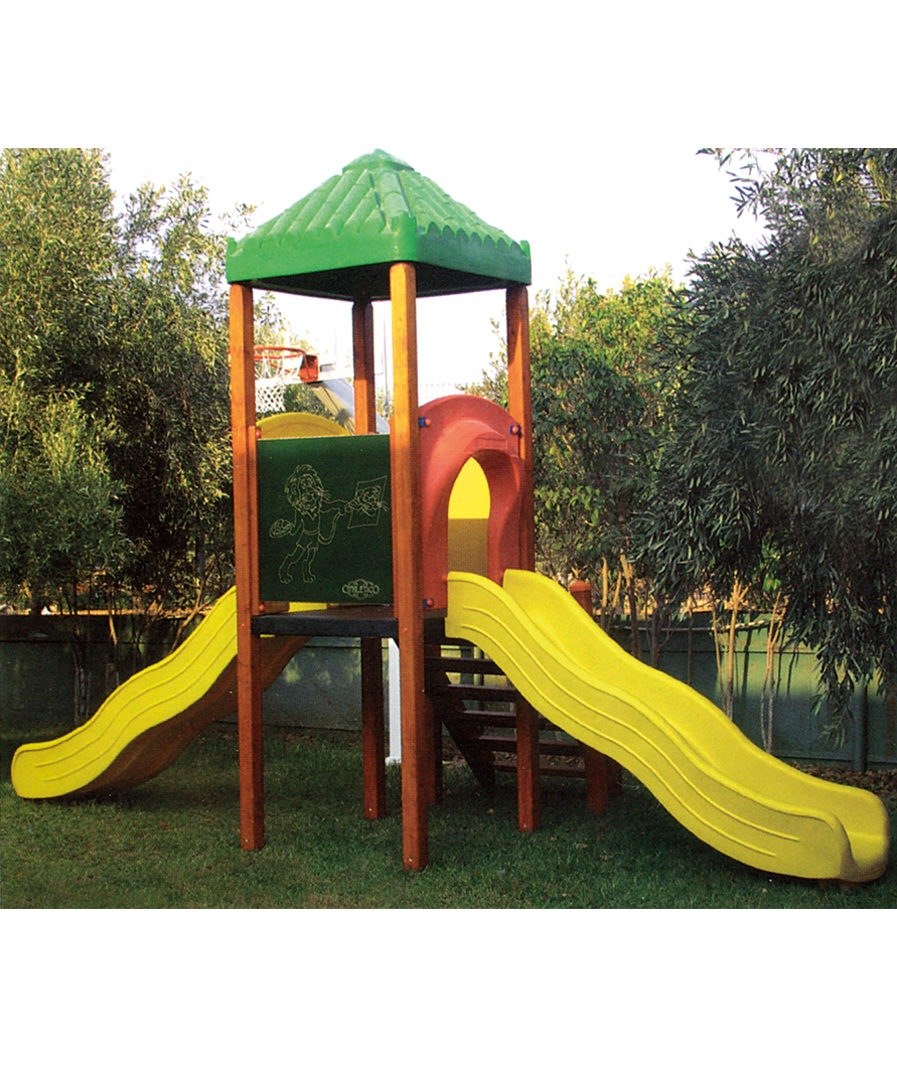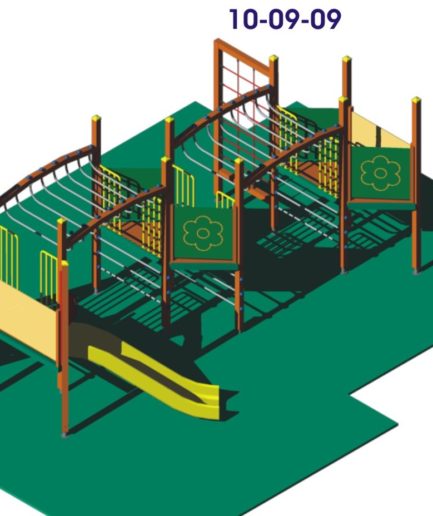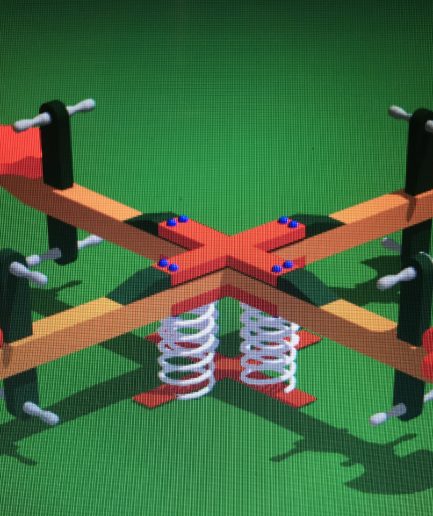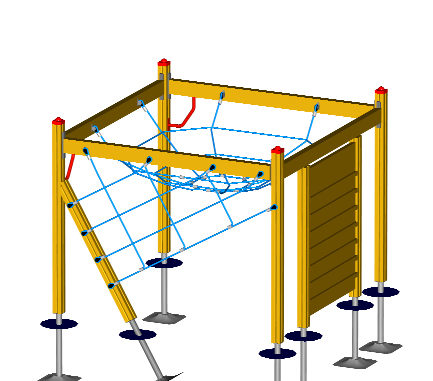WOODEN STRUCTURE 10-07-06
TECHNICAL DESCRIPTION
OF A COMPOSITE STRUCTURE
MOD. 10-07-06
The overall dimensions of the composite structure are 542 Χ 235 cm by 362 high and it comprises:
1 square deck 122 cm height with square roof
2 wavy slide 122 cm
2 hood
Safety panel
1 square plastic roof
plugs for turnbacks
Bedding bases
Square tower 122 cm high with square roof.
The tower is overall dimensioned 111,5X111,5X362 cm and it comprises of:
4 wooden pillars dimensioned 9Χ9 cm. and 302 cm high.
1 pieces of plywood Wireness (antislip) whose the upper side is covered with dark brown antislip surface. The dimensions of each piece is 99X99 cm. And the thickness is 21mm. as the decks floor.
1 plastic roof
WAVY STRAIGHT SLIDE FOR DECK 122 cm.
The wave straight line slide chute is 122 cm high.
It is made with the method of the rotary infusion, being moulded within forming dies. It is moulded by linear, low density polyethylene with stabilizers against the ultra violet radiation and providing antistatic (of static electricity) protection.
The paint to be applied each time, which is non-acid, is added with the rotary infusion of the forming dies. It is in one-piece and is also fitted with a one-piece protection cover made of the same material, to avoid any falls. Such materials comply with:
ASTM – D – 790 Flex Modulus
ASTM – D – 638 Tensile Strength
ASTM – D – 648 Heat Distortion Temperature
ARM – STD Low Temperature Impact
The diameter of the panels must be at least 6 mm thick.
Exceptions, if any, must be stated.
ASTM = the American Society for Testing and Material
The American Materials Testing Service.
HOOD
The hood of the chute obliges the children to leave in a seating position, to prevent accidents.
It is 105 cm high and 87 cm wide.
It is made with the method of the rotary infusion moulded in forming dies. It is moulded from linear low density polyethylene with stabilizers against the ultra violet radiation, providing antistatic (of static electricity) protection.
The paint to be applied each time, which is non-acid, is added with the rotary infusion of the forming dies.
They will comply with the :
ASTM – D – 790 (Flex Modulus )
ASTM – D – 638 (Tensile Strength)
ASTM – D – 648 Heat Distortion Temperature
ARM – STD (Low Temperature Impact
ASTM = the American Society for Testing and Material
The American Materials Testing Service.
PROTECTIVE PANEL
The hood is sized 93,5Χ97,5Χ7 cm. And it consists of :
2 pcs of wood dimensioned 4Χ7Χ96 cm.
1 pc of plywood dimensioned 85,5Χ90Χ2 cm.
Between the two wooden pillars dimensioned 4Χ7Χ96 cm., at a height of 8 cm from their base, is placed the ply wood. The protective panel is place on the free from activities side of the tower to protect kids from falling, in conformity with the ΕΝ 1176.
SQUARE PLASTIC ROOF
The square cover is dimensioned 122Χ122 cm., distance from the centre of the hole 1015 mm long. and 700 mm high.
The cover is made with the method of the rotary infusion moulded in forming dies. It is moulded from linear low density polyethylene with stabilizers against the ultra violet radiation and they provide antistatic (of static electricity) protection.
The paint applied every time, which is non-acid, is added with the rotary infusion of the forming dies.
They will comply with the:
ASTM – D – 790 Flex Modulus
ASTM – D – 638 Tensile Strength
ASTM – D – 648 Heat Distortion Temperature
ARM – STD Low Temperature Impact
ASTM = the American Society for Testing and Material
The American Materials Testing Service.
EMBEDDING BASES
In order to embed the structure into the ground, the pillar is fitted with a pair of embedding bases.
The embedding bases consist of two metallic galvanized plates which are then dyed with electrostatic dyeing process, are «Π» shaped and dimensioned 100Χ12Χ4cm, 0,5cm thick., embracing the pillar; they are linked together with through bolts 5/8Χ15. Their lower part is fitted with a metallic flange to retain them within the concrete-made pit.
Only the embedding irons are embedded in the ground; the former hold down the pillar at a distance of at least 5cm. above the ground, in order to prevent corrosion of the wood due to the humidity of the ground.
TIMBER
The wood which is used for the equipments is a composite non-stick wood of pine tree, Swedish type, in conformity with ΕΝ 351. It is made with a special union (welding of woods) at various cross sections, depending on the use it is intended for.
The COMPOSITE WOOD is by 40% more powerful than the wholesome wood. Its strength is 360 kp/m2 and its special weight is around 480 kg/m3.
▪ It contains approximately 15% humidity
▪ It contains minimum juices (resin) as compared with the other trees of the family of pine tree of the other countries (weather conditions in the Northern Sweden up to -25 ο )
▪Its thermal conductivity is s=0,10 Kcal/Mho and its sound insulation is 3.5 times higher than that of the concrete or brickwork of equal thickness.
▪ It has anti-magnetic qualities and it is non-conductor of the electric current.
▪ It is resistant to fire and it ranks in the classes of F30 and F60 (as per DIN 4120) depending on its cross section.
▪ When the outer part of the cross section is burned, the inner part is protected and retains its strength.
▪It can be processed in the same way as the wood which is sold in the market.
▪It maintains its form and is hard to deform or to crack.
▪The annual rings of the wood are usually vertical to their big side with a significant increase of the mechanical strength of this surface, should it be applied on floors.
All the angles (edges) of woods are shaved in the radial sense 5 mm. at least.
PLYWOOD
The plywood-made parts, which are required for our structures are at least 20 mm thick and are made of wood sheets each 1,5 mm thick, being welded between each other, by way of thermo-welding process under pressure, using resins of phenol base, non-toxic. They are dyed with water-dissoluble paints, in which no sealing compounds have been added, nor any diluting items or dyes, which contain lead, chrome, cadmium or other heavy duty metals. The paints also offer high resistance under adverse weather conditions.
The above sheets of plywood are in conformity with standards ΕΝ 314-2.
The quality of the plywood is such that no further processing is required prior to the dyeing process, such as application of putty.
PLASTIC ELEMENTS
The plastic elements that are required for the manufacture of equipment are highly resistant to the ultra violet radiation and in unfavourable weather conditions. The preferred materials are those which can be recycled such as the polyethylene (ΡΕ) or the polypropylene (ΡΡ). In particular, all the bolts, which stand out of the equipment by more than 5 mm, are covered with plastic plugs of propylene (ΡΡ). Also, they are harmless for the safety and the health of the children.
METAL ELEMENTS
The metal elements that are used for the manufacture of equipment (screws, contacts etc) are manufactured from thermo-galvanised steel (with zinc), electro-galvanised, in which the surface has been previously prepared with sandblast or stainless (stainless steel). The dimensions and the cross sections of the metallic elements are sufficient to accommodate (with the suitable safety coefficient) the loads for which they have been studied to resist corrosion and adverse weather conditions.
PAINTS
The varnishes and the paints with which the wooden parts are protected, have been specifically studied for the climatic conditions of our country (temperature changes, open or closed spaces etc), are entirely harmless for the users (they contain no lead, chrome or cadmium or any other heavy metals) and they give a high resistance in our structures.
EMBEDDING
The embedding of the equipments calls for the following procedure:
At this point in which the pillar is to be fitted, a pit is opened up in the form of truncated cone, 80cm deep approximately, and 60cm in diameter. Afterwards, after the pillar is fitted inside it, the pit is filled up with concrete until it reaches 20cm. from the level of the ground, where it is covered with the ground.
Only the embedding irons are embedded in the ground, which keep down every pillar at a distance of at least 10 cm. from the ground, in order to prevent the corrosion of the wood due the humidity of the ground.
All the procedures of the production works for processing the raw materials are carried out in conformity with
The standards ΕΝ 1176 1-6,
the system of quality ISO 9001 : 2000
and system of environmental management ISO 14001 : 2004






